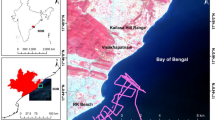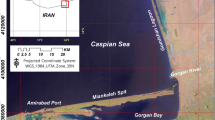Abstract
Map** the thermal fronts is one of the important near-real-time applications of high-resolution sea surface temperature (SST) retrieved from the infrared satellite sensors such as MODIS and AVHRR to help in demarcating the areas of the potential fishing zone (PFZ). The thermal fronts are considered a proxy for the identification of PFZ from numerous studies. However, the complexity of the region and persistent cloud cover generate huge data gaps in SST images, making it challenging to provide thermal front information on a daily and synoptic scale. To overcome such difficulties, we use gap-free and blended Global 1 km SST (G1SST) products with MODIS SST to understand the inherent relationship between the datasets and their coherency to resolve spatiotemporal characteristics at a daily scale. In this regard, an edge detection algorithm developed by Cayula and Cornillon (1992) has been implemented to extract the thermal fronts from the SST datasets during 2014–2020. The algorithm is modified to suit Indian coastal oceans corresponding to MODIS SST and G1SST to resolve thermal gradients based on sensitivity experiments related to satellite-measured Chlorophyll-a and primary productivity datasets. We found that the gradient value of 0.075 °C/km is suitable for MODIS, while a relatively weaker value of 0.07°C/km for the G1SST. The weekly composite datasets of thermal front density (TFD) generated from the daily time series during the study period have been used in the least square-based harmonic analysis to investigate their observed seasonality in the continental shelf region of India. Simulation and analysis from a high-resolution ocean general circulation model have been used to investigate circulation features and associated topographic modulation for elucidating causes of the high-persistent thermal front regimes and their intra-seasonal dynamics.








Similar content being viewed by others
References
Alemany, D., Acha, E. M., & Iribarne, O. O. (2014). Marine fronts are important fishing areas for demersal species at the Argentine Sea (Southwest Atlantic Ocean). Journal of Sea Research, 87, 56–67. https://doi.org/10.1016/j.seares.2013.12.006.
Atmanand, M. A., Purnima Jalihal, M. V. Ramanamurthy, G. A. Ramadass S. Ramesh, K. A. Gopakumar, N. Vedachalam, G. Dharani, (2019). Blue Economy - Opportunities for India, IEEE web hosting.
Belkin, I. M. (2009). Observational studies of oceanic fronts. Journal of Marine Systems. https://doi.org/10.1016/j.jmarsys.2008.10.016.
Belkin, I. M., & O’Reilly, J. E. (2009). An algorithm for oceanic front detection in chlorophyll and SST satellite imagery. Journal of Marine Systems. https://doi.org/10.1016/j.jmarsys.2008.11.018.
Belkin, I. M., Cornillon, P. C., & Sherman, K. (2009). Fronts in Large Marine Ecosystems. Progress in Oceanography. https://doi.org/10.1016/j.pocean.2009.04.015.
Blumberg, A.F., & Mellor, G.L. (2012). A description of a three-dimensional coastal ocean circulation model. https://doi.org/10.1029/co004p0001.
Brink, K.H., (1987). Upwelling fronts: Implications and unknowns. South African Journal of Marine Science. https://doi.org/10.2989/025776187784522315.
Cayula, J. F., & Cornillon, P. (1992). Edge detection algorithm for SST images. Journal of Atmospheric Océanistes Technologies. https://doi.org/10.1175/1520-0426(1992)009%3c0067.
Chakraborty, K., Maity, S., Lotliker, A. A., Samanta, A., Ghosh, J., Masuluri, N. K., Swetha, N., & Bright, R. P. (2019). Modelling of marine ecosystem in regional scale for short term prediction of satellite-aided operational fishery advisories. Journal of Operational Oceanography. https://doi.org/10.1080/1755876X.2019.1574951.
Chao, Y., Li, Z., Farrara, J. D., & Hung, P. (2009). Blending sea surface temperatures from multiple satellites and in situ observations for coastal oceans. Journal of Atmospheric and Oceanic Technology. https://doi.org/10.1175/2009JTECHO592.1
Choudhury, S. B., Jena, B., Rao, M. V., Rao, K. H., Somvanshi, V. S., Gulati, D. K., & Sahu, S. K. (2007). Validation of integrated potential fishing zone (IPFZ) forecast using satellite based chlorophyll and sea surface temperature along the east coast of India. International Journal of Remote Sensing. https://doi.org/10.1080/01431160600987878.
Condie, K. C. (1993a). Chemical composition and evolution of the upper continental crust; Contrasting results from surface samples and shales. Chemical Geology. 104, 1–37. https://doi.org/10.1016/0009-2541(93)90140-E.
Condie, S. A. (1993b). Formation and stability of shelf break fronts. Journal of Geophysical Research. https://doi.org/10.1029/93jc00624
Dwivedi, R.M., Solanki, H.U., Nayak, S.R., Gulati, D., Somvanshi, V.S. (2005). Exploration of fishery resources through integration of ocean colour with sea surface temperature: Indian experience. Indian Journal of Marine Science 1399.
IBE,(2020). India’s Blue Economy-A draft policy framework.
Jishad, M., Sarangi, R. K., Ratheesh, S., Ali, S. M., & Sharma, R. (2019). Tracking fishing ground parameters in cloudy region using ocean colour and satellite-derived surface flow estimates: A study in the Bay of Bengal. Journal of Operational Oceanography. https://doi.org/10.1080/1755876X.2019.1658566.
Jishad, M.,& Neeraj Agarwal. (2020) Thermal front detection using satellite-derived sea surface temperature in the northern Indian Ocean: Evaluation of gradient-based and histogram-based methods. Journal of the Indian Society of Remote Sensing, pp. 1–9.
Kawanishi, T., Sezai, T., Ito, Y., Imaoka, K., Takeshima, T., Ishido, Y., Shibata, A., Miura, M., Inahata, H., & Spencer, R. W. (2003). The advanced microwave scanning radiometer for the earth observing system (AMSR-E), NASDA’s contribution to the EOS for global energy and water cycle studies. IEEE Transactions on Geoscience and Remote Sensing. https://doi.org/10.1109/TGRS.2002.808331.
Kilpatrick, K. A., Podestá, G., Walsh, S., Williams, E., Halliwell, V., Szczodrak, M., Brown, O. B., Minnett, P. J., & Evans, R. (2015). A decade of sea surface temperature from MODIS. Remote Sensing of Environment. https://doi.org/10.1016/j.rse.2015.04.023.
Lapeyre, G. (2009). What vertical mode does the altimeter reflect? On the decomposition in baroclinic modes and on a surface-trapped mode. Journal of Physical Oceanography, 39, 2857–2874. https://doi.org/10.1175/2009jpo3968.1.
Laurs, R. M., Fiedler, P. C., & Montgomery, D. R. (1984). Albacore tuna catch distributions relative to environmental features observed from satellites. Deep Sea Research, 31(9), 1085–1099. https://doi.org/10.1016/0198-0149(84)90014-1.
Levitus, S. (1982). Climatological Atlas of the World Ocean. EOS. Transactions of the American Geophysical. Union. Doi: https://doi.org/10.1029/EO064i049p00962-02.
Loder, J. W. (1980). Topographic rectification of tidal currents on the sides of Georges Bank.
Madhupratap, M., Gauns, M., Ramaiah, N., Prasanna Kumar, S., Muraleedharan, P. M., De Sousa, S. N., Sardessai, S., & Muraleedharan, U. (2003). Biogeochemistry of the Bay of Bengal: Physical, chemical and primary productivity characteristics of the central and western Bay of Bengal during summer monsoon 2001. Deep Research Part II Topical Studies in Oceanography. https://doi.org/10.1016/S0967-0645(02)00611-2.
Maze, R. (1998). Tidal rectification: Friction or not friction? Journal of Physical Oceanography, 28, 1333–1345.
Mellor, G. L., & Yamada, T. (1982). Development of a turbulence closure model for geophysical fluid problems. Reviews of Geophysics. https://doi.org/10.1029/RG020i004p00851.
Mishra, S. K. Gourav Nayak, R. K. Nayak, V. K. Dadhwal, (2016) Seasonal dynamics of circulation in Hooghly Estuary and its adjacent coastal oceans," Proc. SPIE 9882, Remote Sensing and Modeling of the Atmosphere, Oceans, and Interactions VI, 988220 doi: https://doi.org/10.1117/12.2223882.
Mishra, S. K., Nayak, R. K., Mahanty, P. C., Seshasai, M.V.R., Dadhwal, V. K. (2019) Tidal circulation in the Hooghly Estuary and Adjacent Coastal Oceans. Journal of the Indian Society of Remote Sensing, 49.
Mohanty, P. C., Mahendra, R. S., Nayak, R. K., Kumar, N., Srinivasa Kumar, T., & Dwivedi, R. M. (2017). Persistence of productive surface thermal fronts in the northeast Arabian Sea. Regional Studies in Marine Science. https://doi.org/10.1016/j.rsma.2017.09.010.
Nayak, R. K., Salim, M., Sasamal, S. K., Mohanthy, P. C., Bharadwaj, R. K., Rao, K. H., Dutt, C. B. S., & Dadhwal, V. K. (2016). Assessment of SARAL-ALTIKA tidal corrections in the Coastal Oceans Around India. Marine Geodesy. https://doi.org/10.1080/01490419.2016.1200699
Nayak, R.K., Salim, M., Mitra, D., Sridhar, P.N., Mohanty, P.C., & Dadhwal, V.K. (2014) Tidal and residual circulation in the Gulf of Khambhat and its Surrounding on the West Coast of India. Journal of the Indian Society of Remote Sensing.
Papoutsa, C., Miltiadou, M., Karathanassi, V., Kolokousis, P., Lafon, V., Sykas, D., Sarelli, A., Prodromou, M., & Hadjimitsis, D. (2018). Detection of marine fronts: a comparison between different approaches applied on the SST product derived from Sentinel-3 data. Doi: https://doi.org/10.1117/12.2324126.
Rao, S. A., Gopalakrishna, V. V., Shetye, S. R., & Yamagata, T. (2002). Why were cool SST anomalies absent in the Bay of Bengal during the 1997 Indian Ocean Dipole event? Geophysical Research Letters. https://doi.org/10.1029/2001GL014645.
Robertson, R. (2004). Internal tides and baroclinicity in the southern Weddell Sea: 1. Model description. Journal Geophysical Research Oceans. https://doi.org/10.1029/2000jc000475
Salim, M., Nayak, R. K., Mohanthy, P. C., Sasamal, S. K., Dadhwal, V. K., Dutt, C. B. S., & Rao, M. S. (2015). Characterization of the seasonal circulation patterns and its application on oil spill transport in the northwestern continental shelf of India. Marine Geodesy. https://doi.org/10.1080/01490419.2015.1008709.
Sarkar, K., Aparna, S. G., Dora, S., & Shankar, D. (2019). Seasonal variability of sea-surface temperature fronts associated with large marine ecosystems in the north Indian Ocean. Journal of Earth System Science, 128, 20. https://doi.org/10.1007/s12040-018-1045-x.
Sarma, V. V. S. S., Desai, D. V., Patil, J. S., Khandeparker, L., Aparna, S. G., Shankar, D., D’Souza, S., Dalabehera, H. B., Mukherjee, J., Sudharani, P., & Anil, A. C. (2018). Ecosystem response in temperature fronts in the northeastern Arabian Sea. Progress in Oceanography. https://doi.org/10.1016/j.pocean.2018.02.004.
Simpson, J. J. (1990). On the accurate detection and enhancement of oceanic features observed in satellite data. Remote Sensing of Environment. https://doi.org/10.1016/0034-4257(90)90052-N.
Solanki, H. U., Dwivedi, R. M., & Nayak, S. R. (2001). Synergistic analysis of SeaWiFS chlorophyll concentration and NOAA-AVHRR SST features for exploring marine living resources. International Journal of Remote Sensing, 22, 3877–3882. https://doi.org/10.1080/01431160110069845.
Ullman, D. S., & Cornillon, P. C. (1999). Satellite-derived sea surface temperature fronts on the continental shelf off the northeast US coast. Journal of Geophysical Research Oceans. https://doi.org/10.1029/1999JC900133.
Ullman, D. S., & Cornillon, P. C. (2000). Evaluation of front detection methods for satellite-derived SST data using in situ observations. Jouranl of Atmospheric and Oceanic Technology. https://doi.org/10.1175/1520-0426(2000)017%3c1667:EOFDMF%3e2.0.CO;2.
Vipin, P., Sarkar, K., Aparna, S. G., Shankar, D., Sarma, V. V. S. S., Gracias, D. G., Krishna, M. S., Srikanth, G., Mandal, R., Rama Rao, E. P., & SrinivasaRao, N. (2015). Evolution and sub-surface characteristics of a sea-surface temperature filament and front in the northeastern Arabian Sea during November-December 2012. Journal of Marine Systems, 150, 1–11. https://doi.org/10.1016/j.jmarsys.2015.05.003.
Funding
The authors have no relevant financial or non-financial interests to disclose. This study was funded by ISRO Biosphere and Geosphere Program.
Author information
Authors and Affiliations
Corresponding author
Ethics declarations
Conflict of interest
I confirm that all authors of the manuscript have no conflict of interests to declare.
Additional information
Publisher's Note
Springer Nature remains neutral with regard to jurisdictional claims in published maps and institutional affiliations.
About this article
Cite this article
Swapna, M., Raju, R., Nayak, R.K. et al. Spatiotemporal Characteristics of Thermal Fronts in Relation to Potential Fishing Zones in the Continental Shelf Sea Around India. J Indian Soc Remote Sens 51, 335–348 (2023). https://doi.org/10.1007/s12524-022-01629-1
Received:
Accepted:
Published:
Issue Date:
DOI: https://doi.org/10.1007/s12524-022-01629-1




